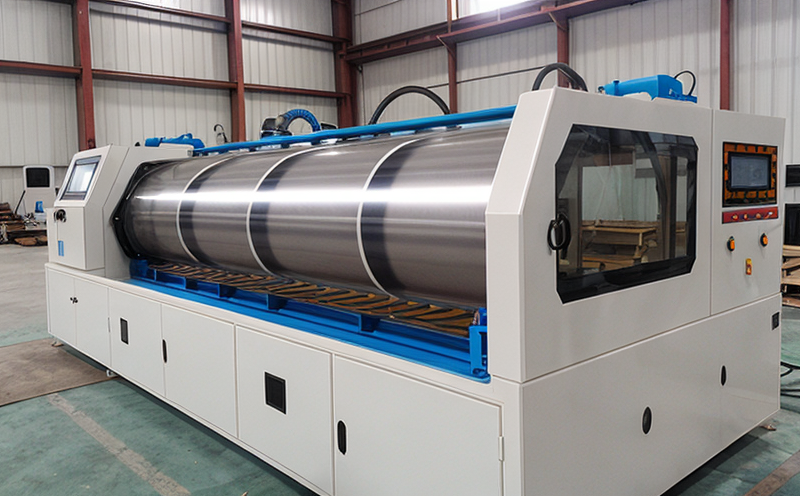ISO 4649 Rubber coated fabrics Determination of abrasion resistance
The ISO 4649 standard provides a method to determine the abrasion resistance of rubber coated fabrics. This service is essential for quality control and compliance, particularly in sectors involving textiles that require durability under abrasive conditions such as automotive interiors, upholstery, and industrial equipment.
The test involves the use of an Abraflex machine which applies controlled friction against a specified area of the fabric sample over a set period. The amount of rubber coating wear is measured by comparing the initial and final weights or thicknesses of the coated fabric. This process ensures that the rubber coating adheres well to the substrate, providing protection against abrasion.
The method described in ISO 4649 is critical for ensuring product quality and meeting regulatory requirements. It helps manufacturers identify potential issues with their products early in the development cycle, allowing for necessary adjustments before production begins. This proactive approach can significantly reduce costs associated with rework or returns due to non-compliance.
During specimen preparation, it's important to ensure that the sample is representative of the product as a whole. Samples should be cut from different areas of the fabric to account for variability within the batch. Proper conditioning and storage conditions are also crucial; samples must be stored in an environment similar to those expected during use to avoid altering their properties.
The equipment used includes an Abraflex machine, which applies controlled friction against the sample. Other essential items include balances capable of measuring weight accurately down to a few milligrams, micrometers for thickness measurement, and possibly a scanning electron microscope (SEM) or other surface analysis tools depending on additional requirements such as identifying wear mechanisms.
The test procedure typically consists of several steps: preparation of the specimen according to specified dimensions; conditioning under controlled conditions; application of abrasive action using the Abraflex machine with defined parameters like speed, pressure, and type of abradant; measurement before and after testing; reporting results based on changes observed. Results can then be compared against industry standards or internal targets to assess performance.
Understanding the implications of this test is vital for quality managers looking to ensure their products meet necessary abrasion resistance levels without compromising other qualities like flexibility, appearance, etc. By adhering strictly to ISO 4649 guidelines, companies can demonstrate compliance with relevant regulations while maintaining competitive edge through superior product performance.
For those involved in research and development (R&D), this service offers valuable insights into material behavior under specific conditions which could inform future innovations or improvements. Similarly, procurement teams may benefit from knowing how different suppliers perform according to these standards when selecting materials for new projects.
Environmental and Sustainability Contributions
The determination of abrasion resistance as per ISO 4649 plays a crucial role in promoting sustainability within the textile industry. By ensuring that rubber-coated fabrics possess adequate durability, manufacturers can extend product lifecycles, reducing waste generation and resource consumption.
Abrasion-resistant coatings help protect against wear and tear caused by environmental factors such as sunlight exposure or mechanical stress from daily use. This extended life span not only benefits consumers but also contributes positively to the environment by decreasing demand for new products and lowering overall carbon footprints associated with manufacturing processes.
Additionally, this service supports sustainable practices by facilitating innovation aimed at developing more efficient materials that perform better under adverse conditions without sacrificing eco-friendliness. Such advancements can lead to reduced energy consumption during production stages since less frequent replacements are required over time.
Manufacturers who adopt strict adherence to ISO 4649 guidelines contribute significantly towards fostering a culture of responsible manufacturing across the sector. They set benchmarks for industry best practices, encouraging other companies to follow suit in order to maintain high standards globally.
Competitive Advantage and Market Impact
The ability to accurately determine abrasion resistance according to ISO 4649 provides significant competitive advantages in the textile market. Consumers increasingly value durability, especially when purchasing products that will be subjected to frequent use or harsh environments.
Companies capable of demonstrating compliance with this international standard not only meet but exceed regulatory requirements, establishing themselves as leaders in quality assurance. This can enhance brand reputation and customer trust, leading to increased sales and market share.
In competitive markets, having reliable data on the abrasion resistance properties of rubber-coated fabrics allows companies to make informed decisions about material selection and design optimizations. For instance, understanding how different substrates interact with various types of rubber coatings enables manufacturers to tailor solutions specifically for target applications, thereby enhancing product performance.
Moreover, this service helps identify areas where improvements can be made, whether through optimizing existing formulations or exploring new technologies that offer enhanced abrasion resistance properties. Continuous improvement processes fueled by robust testing methodologies like ISO 4649 contribute to long-term competitiveness in the industry.
Use Cases and Application Examples
| Application Example | Description |
|---|---|
| Automotive Interior Fabrics | Rubber-coated fabrics used in car seats and dashboards must withstand significant abrasion from daily use. Testing according to ISO 4649 helps manufacturers ensure these components last longer, enhancing customer satisfaction. |
| Upholstery for Public Spaces | Such as hotel lobbies or office waiting areas where high traffic is expected. Ensuring the rubber-coated upholstery can withstand frequent handling extends its useful life and reduces maintenance costs. |
| Application Example | Description |
|---|---|
| Industrial Equipment Covers | Coated fabrics used to cover conveyor belts or other machinery parts exposed to abrasive substances need robust abrasion resistance. ISO 4649 testing ensures these components perform reliably under harsh conditions. |
| Sports Apparel | Rubber-coated surfaces on sportswear, such as running shoes or gloves, benefit from this type of testing to ensure they maintain their protective quality throughout extensive use. |





